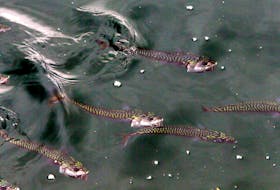In the Upper Gulf of California, Mexico, gillnets used in the shrimp fishery have received much of the blame for the plunge in the numbers of a rare marine mammal known as the vaquita.
There are only about 30 of the small porpoises believed left in existence and the fear is that extinction of the species may come in 2018 unless major changes are implemented.
One of the key challenges is to encourage Mexican fishermen to change from traditional fishing gear — to get rid of the kilometre-long walls of gillnets in the water that entangle and drown vaquita and other bycatch — and use alternative fishing gear that will be more selective and vaquita-friendly.
Such alternative gear is being tested this week in the flume tank of the Centre for Sustainable Aquatic Resources at the Fisheries and Marine Institute of Memorial University in St. John’s.
Yann Herrera, fishing technologies co-ordinator of the oceans program with the World Wildlife Fund Mexico, said having access to the flume tank is a huge benefit to the team testing the alternative fishing gear.
“The tank here at Memorial University is a one-of-a-kind facility. We don’t have anything like this in Mexico,” he said.
“We want to improve the hydrodynamic efficiency of some of the nets that we are proposing to use in the Upper Gulf of California as an alternative to gillnets. Gillnets are essentially killing everything we have in the ocean. They are nets that are highly effective at catching things, but are really unselective and catch everything that’s in their way. So there’s a lot of bycatch of protected species, a lot of bycatch of turtles and sharks and other finfish species that shouldn’t be getting caught.
There is an urgent need to get away from gillnets and start using things that are a bit more selective.”
World Wildlife Fund Mexico arranged for a delegation of fishermen, fishing gear designers and representatives of an international expert committee on fishing technologies to come to St. John’s to test a new design of trawl in the flume tank.
Paul Winger, director of the Centre for Sustainable Aquatic Resources and a member of the expert committee, said the work being done this week is for a critical conservation issue that has become an international concern. He said the international committee working on the issue is made up of representatives from Mexico, Denmark, the United Kingdom, Sweden, the United States and Canada.
“We are talking about trying to save the last remaining 30 vaquita dolphins, which are really a small porpoise that live in the Upper Gulf of California, and it has been declining for many years,” Winger said.
“The Marine Institute has been working with partners in the Upper Gulf of California, Mexico, with Mexican fishermen for over a decade. The issue has escalated, with less than 30 or so animals. And there’s formed an international committee of gear technologists.
“So what we are looking for are ways to catch shrimp and other species in a vaquita-friendly way. So it’s about a gear technology solution.”
Winger noted it may seem strange in Newfoundland and Labrador to be talking about gillnets catching shrimp, but the shrimp species targeted in the Upper Gulf of California are large shrimp, mainly the blue and brown species.
The trawls being tested this week, he noted, are for use on small boats.
“We are thrilled to be a part of it,” Winger said. “We are part of the solution and what we bring to the table is our flume tank. We have the only flume tank in the Western Hemisphere. Yes, there are other flume tanks in Denmark, China, Japan, France and Australia, but we have the only one in North and South America. So even fishermen in the Upper Gulf of California, which seems like a long way away, are here this week trying to find new solutions using our one-of-a-kind flume tank.”
As fishermen in Newfoundland and Labrador have different opinions on fishing gear and fishery problems, so do Mexican fishermen.
Antonio Garcia, of San Felipe, Baja California, Mexico, was a fisherman for 35 years before moving into the business of making alternative fishing gear. He is now self-employed and designs and constructs trawls and other types of gear in his workshop.
Garcia said San Felipe has a population of about 50,000 people, about 70 per cent of whom work in the fishing industry. Most, he said, are small-boat fishermen who fish in vessels about 25 feet long, while others are involved in the industrial sector in vessels of about 60 feet.
The fishery is conducted year-round on species such as shrimp, flounder, crab, lobster, rays and groupers (large or heavy-bodied fish of the sea bass family found in warm seas).
He said fishermen have different views on switching from fishing gear that they’ve used all their lives.
“They feel a bit angry. They are hesitant and resistant to change to other gear,” Garcia said, as translated by Herrera.
“They mainly use gillnets. Some of the things we are testing are small trawls, pots and traps.
“The bycatch problem is really bad mostly due to corruption. Authorities don’t really act the way they should and are letting illegal fishing continue and catching species that shouldn’t be caught.”
Garcia said they are working to change attitudes.
“I am positive that the new technology will help reduce bycatch, help protect endangered species. However, while we are progressing there is still a lot of work to do and a lot to get accomplished,” he said. “The technology will help as long as the fishers have the will to change.”
The World Wildlife Fund Mexico notes that in June 2017, after two years of a temporary ban on gillnets, the Mexican government announced a permanent ban, which was implemented jointly with a program that compensates fishermen for not fishing.
That was a big step in trying to save the vaquita.
Vaquitas are highly elusive and were discovered only in 1958. Rapid population declines led to the vaquita being listed as critically endangered in 1996, when several hundred vaquita remained. The hope is the species can recover and rebuild from its current population of about 30 in the Upper Gulf of California — the only place the vaquita are known to exist.
The World Wildlife Fund is also working with partners to retrieve abandoned gillnets (ghost nets) which continue entangle and kill vaquita and other marine species. From October 2016 to July 2017, more than 500 nets were removed from vaquita habitat.








